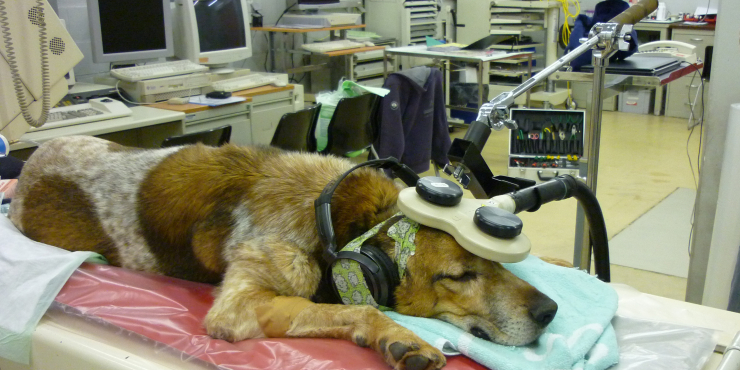- Home
- Nuclear medicine (diagnostics and therapy) (vet)
Nuclear medicine (diagnostics and therapy) (vet)
Scintigraphy is a medical imaging technique that uses radioactive substances (isotopes) and is used when traditional medical imaging (X-rays, CT, ultrasound) does not provide sufficient information about an animal's problem or disorder.
The substances are harmless for your animal and the radiation load is minimal. The radioactive particle loses its radiation after a period of time. This is called half-life. It varies according to the substance and determines how long your pet emits radioactivity. Not only the decay of the isotope, but also the pace at which your animal secretes the substance through urine or faeces is important.
The technique is very sensitive so it can show problems at a very early stage. Another advantage of this technique is that it can often show an image of the entire animal which is not that obvious with other techniques. The results in scintigraphy are often combined with other medical imaging techniques to come to a correct diagnosis.
Scintigraphy is recommended for examining:
- hyperthyroidism in cats: cats often have an overactive thyroid gland at a middle or advanced age that produces too many thyroid hormones. Often benign tumours cause hyperthyroidism, but the cat's general health suffers from the surplus of hormones. Although there are different medical treatments, treatment with radioactive iodine (which is also carried out in humans) is considered the best for hyperthyroidism.
- hypothyroidism in dogs - when the thyroid gland functions too slowly (when blood examination doesn't provide a correct diagnosis).
- thyroid tumours. Some patients also benefit from treatment with radioactive iodine. This is a therapy that is carried out in our clinic.
- limping Through scintigraphy of the bone we can localize the injury. The technique is often combined with orthopedic and neurologic examinations.
- tracing a portosystemic shunt (abnormal blood vessel in the liver). Usually a an ultrasound is carried out, but liver scintigraphy can help to make a diagnosis by imaging the course of the blood vessels in the stomach.
- visualizing the activity of each kidney separately.
You can find more information about hyperthyroidism in cats here.
Orsami
Universiteit Gent - Faculteit Diergeneeskunde
Salisburylaan 1339820 MerelbekeBelgiëBE 0248.015.142
secretariaat.khd@ugent.be+32 9 264 77 00 (kleine huisdieren)+32 9 264 76 18 (grote huisdieren)
Openingsuren
| ma: | 8 - 12 u. | 12 - 16 u. |
| di: | 8 - 12 u. | 12 - 16 u. |
| wo: | 8 - 12 u. | 12 - 16 u. |
| do: | 8 - 12 u. | 12 - 16 u. |
| vr: | 8 - 12 u. | 12 - 16 u. |
| za: | Gesloten | Gesloten |
| zo: | Gesloten | Gesloten |

